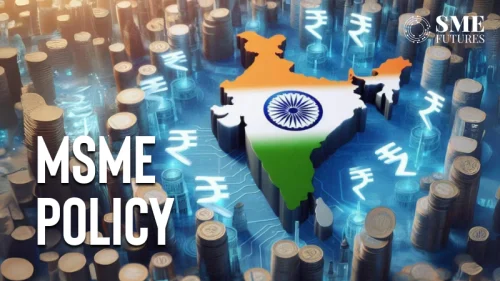In her sixth budget presentation, Nirmala Sitharaman celebrated a decade of positive economic transformation in India.
In her interim budget speech, Sitharaman painted a vivid picture of the Indian economy undergoing a profound positive transformation. “The last 10 years have witnessed a metamorphosis in the Indian economy,” she proclaimed, setting the tone for a budget.
Emphasising the government’s commitment to inclusive development, Sitharaman invoked the visionary mantra of “Sabka Saath, Sabka Vikas, and Sabka Vishwas” that has guided the nation’s progress in the past decade. In her address, she pinpointed the critical pillars deserving attention — the underprivileged, women, the dynamic youth, and the backbone of the nation, the annadatas or farmers. “Our focus must be unwavering on these four pillars — the poor, women, youth, and our annadatas,” Sitharaman declared, urging a collective effort towards their upliftment.
Despite the suspense that usually accompanies budget speeches regarding tax changes, Sitharaman maintained the status quo in this fiscal plan. No tweaks to the taxation regimes; the existing tax rates for direct and indirect taxes, including import duties, were to remain unchanged. The finance minister’s decision to retain these rates underscored a commitment to stability, providing a sense of assurance to businesses and taxpayers alike.
Analysts, dissecting the nuances of Sitharaman’s budget, recognised a strategic move aimed at fostering economic resilience and recovery. The extension of tax benefits was seen as a calculated step aligning with a broader vision of ensuring policy continuity. This, in turn, was expected to instill confidence and stability within the business landscape, fostering an environment conducive to sustained growth.
As the curtains fall for the govt’s last budget, experts chimed in with their insights on the interim budget for 2024. The financial landscape seems poised for a dynamic future, and only time will reveal the true impact of these fiscal decisions on the Indian economy.
India Budget: Consolidation Ahoy!
The interim budget is short of any big bang announcements, but the policy prerogatives and spirit has not been derailed says Madhavi Arora, Lead Economist – Emkay Global Financial Services.
“There has been continued pace of fiscal consolidation in line with the fiscal road map and policy priorities further getting more targeted and focussed. Fiscal counter-cyclicality is a welcome move amidst improving growth impulse as it addresses the challenging debt dynamics. However, the scaling back of centre’s fiscal both in FY24 (5.8%) and FY25BE (5.1%) has come on the back of states’ mild fiscal slippage to ~3.1% of GDP,”
She welcomed the relief and focussed measures for the rural/farm/welfare sector and also continued focus on infra and green energy. “Increased focussed on innovation and R&D with Rs1tn+ will also improve economic capacities and productivity. There were no any major announcements for tax mobilisation and rationalisation, as expected. That said, the gross tax/GDP ratio will likely rise to highs of 11.7% in FY25BE despite easing tax growth,” she says.
Prudent, not populist budget
There was an expectation that given it’s an election year, the budget could tilt more populist with more support for rural sector. However, contrary to expectations, the government continues to be driven by development and fiscal prudence as the central focus.
Unanimously, India inc is of the same opinion.
Chirag Mehta, CIO at Quantum AMC feels given the economic growth momentum , there was need for assuring macroeconomic stability which has been judiciously crafted to give way for fiscal consolidation.
“The lower tax collection assumption could either be conservative or government signal to assume some growth moderation going forward. The government continues it capital expenditure spending with on Inclusive development with Agri, Infra (including housing) and Green ecosystem as the key thrust areas with an emphasis on Research and Technological developments,” he says.
However, according to him, there was a need to support manufacturing momentum and way to revive rural economy. “Probably that could be part of the main budget that gets presented in July as government plans to showcase a pathway for Developed India,” he comments.
According to Dr. VP Singh, Director – PGDM and Professor – Managerial Economics & Statistics, Great Lakes Institute of Management, Gurgaon, this budget exudes NDA government’s confidence while going into general election in few months from now.
“Populism has been shunned while prudence has been observed. The Ram temple wave has swayed the political dividend in favour of NDA which in turn gives the government some room to bring in fiscal discipline and boost economic development,”
Dr Singh opines that government maintaining fiscal discipline as per the envisaged glide path should be seen as a great virtue. Despite the fiscal discipline the government delivered the fastest GDP growth rate among large economies of the world.
“To maintain the strong growth momentum, the capex has been increased to a record of Rs 11.1 trillion. This comes to nearly 10 per cent increase from last year’s budget. As expected, the growth in capex has been slowed and more emphasise being given to agents of financial inclusivity.
A growth-oriented budget
Venkatraman Venkateswaran – Group President & Chief Financial Officer at Federal Bank says “Overall it’s a growth-oriented budget.” According to him, the government has clearly laid out the fiscal deficit path for next two years, and this is one of the highlights of the interim budget.
“The tax to GDP ratio has improved which gives the confidence to spend more and is a major contributor to the glide path for fiscal deficit. Secondly the continued focus on infrastructure and affordable housing is a big positive,” he says.
While Dr Tulsi Jayakumar, Professor, Finance & Economics, at SP Jain Institute of Management and Research (SPJIMR) says Today’s budget, a Vote of Account, is important for the policy directions provided were the government to come back to power in the Lok Sabha Elections 2024.
However, he points out that the challenge for the government will be to ensure private final consumption expenditure to increase and keep the inflation under control.
“The biggest challenge today is to revive animal spirits and promote private investment. The FM has announced an increase in government outlay by 11.1% on capital expenditure. This together with a reduction in the Fiscal Deficit -government borrowings essentially — from 5.8% of GDP in 2023-24 to 5.1% of GDP in 2024-25, is expected to facilitate greater borrowings by private sector. Such capex had increased by 33% in the previous budget as well, however had not really spurred private investment,” he comments.
Something for everyone
Dissecting the interim budget, India inc also opines that there is something for everyone.
Kishore Lodha, Chief Financial Officer, U GRO Capital comments “Overall, this Union budget has been an excellent budget – it consists of something for everyone. Notably, the Government’s commitment to green growth and energy infrastructure is commendable. The announcement of one crore solar units by the Prime Minister marks a significant stride, alleviating financial burdens on households and addressing environmental concerns,”
The overall focus on GYAN initiative, which is Garib (Poor), Yuva (Youth), Annadata (Farmer) and Nari (Woman), will benefit the most economically disadvantaged individuals. The next year’s deficit target has been kept as 5.1%, which is a pleasant surprise. Borrowing will be lesser compared to this year which is good news for the financial markets,”
Extending Ayushman Bharat cover to Anganwadi and Asha workers, alongside consolidating maternal and child healthcare schemes, aims to address rural health challenges and fosters opportunities for Healthcare MSMEs who are crucial contributors to the healthcare sector’s revenue growth. To achieve the vision of a $7 trillion economy, accelerating digitalisation is paramount in today’s evolving digital global fabric, he adds.
Jyoti Prakash Gadia, Managing Director at Resurgent India says there were large expectations across all segments, it is an opportunity for the government to showcase its ambitious plans just before the next general elections.
“The FM has accordingly chosen to concentrate on the initiatives already taken by them in the fields of agriculture, dairy farming, MSME and infrastructure with a long-term perspective in mind. The emphasis on the tourism sector is a welcome move considering the immense potential we have and the bad times it faced during the pandemic. The overall announcements are on expected lines as a part of the interim budget without any major announcements of specific areas,”
The FM is relying upon the strategy of maintaining continuity and consistency to prove their point in favour of a brighter future with a comprehensive set of reforms set out in due course, he adds.
A good budget for bond market
According to analyst, the budget would go well with the market, especially for the bond market as the government chose fiscal prudence over populist spending.
Pankaj Pathak, Fund Manager- Fixed Income, Quantum AMC comments that the faster fiscal consolidation and consequent decline in the government’s market borrowing should drive bond yields lower and bond prices higher.
“Another positive aspect is that the government has pegged only a moderate growth in the non-capex expenditure. This should keep inflation under check and provide enough headroom to the RBI to cut interest rates. We expect long term bonds to do well in 2024. Investors can capture this opportunity with dynamic bond funds which are invested in long term bonds.”











